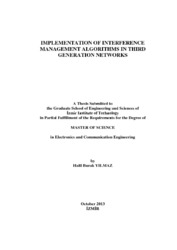Please use this identifier to cite or link to this item:
https://hdl.handle.net/11147/3673Full metadata record
| DC Field | Value | Language |
|---|---|---|
| dc.contributor.advisor | Özbek, Berna | en |
| dc.contributor.author | Yılmaz, Halil Burak | - |
| dc.date.accessioned | 2014-07-22T13:52:06Z | - |
| dc.date.available | 2014-07-22T13:52:06Z | - |
| dc.date.issued | 2013 | en |
| dc.identifier.uri | http://hdl.handle.net/11147/3673 | - |
| dc.description | Thesis (Master)--Izmir Institute of Technology, Electronics and Communication Engineering, Izmir, 2013 | en |
| dc.description | Includes bibliographical references(leaves: 89-90) | en |
| dc.description | Text in English; Abstract: Turkish an English | en |
| dc.description | xi, 90 leaves | en |
| dc.description | Full text release delayed at author's request until 2016.08.26 | en |
| dc.description.abstract | As a rapidly growing network UMTS, the 3rd generation mobile communication system, is designed to provide sufficient capacity for the services requiring high bit rates. The WCDMA technology has been chosen for the technique of UMTS in which all connections are able to use the same frequency band and time thanks to orthogonal and pseudorandom codes. As a result of using the same frequency band, interference management is a key in optimizing the network capacity and coverage. Therefore, a practically applicable algorithm is needed. However, the existing algorithms generally present iterative methods which are difficult to be applied for mobile network operators in that iterative methods require more man power and increase costs. In this thesis, we present a two-step method that will decrease interference in UMTS Networks according to received power measurement results and network initial configuration by adapting antenna tilt, azimuth and Common Pilot Channel (CPICH) power since those parameters have direct impact on coverage area in terms of shape and size. First step calculates base stations antenna downtilt and CPICH power while second step adopting azimuths. The performances of proposed algorithms are obtained considering practical scenarios. The results have shown that antenna tilt, pilot power and azimuth can be used successfully in managing interference for UMTS Networks. | en |
| dc.language.iso | en | en_US |
| dc.publisher | Izmir Institute of Technology | en |
| dc.rights | info:eu-repo/semantics/openAccess | en_US |
| dc.subject.lcsh | Universal Mobile Telecommunications System | en |
| dc.subject.lcsh | Mobile communication systems | en |
| dc.title | Implementation of interference management algorithms in third generation networks | en_US |
| dc.type | Master Thesis | en_US |
| dc.institutionauthor | Yılmaz, Halil Burak | - |
| dc.department | Thesis (Master)--İzmir Institute of Technology, Electrical and Electronics Engineering | en_US |
| dc.relation.publicationcategory | Tez | en_US |
| item.fulltext | With Fulltext | - |
| item.openairecristype | http://purl.org/coar/resource_type/c_18cf | - |
| item.openairetype | Master Thesis | - |
| item.cerifentitytype | Publications | - |
| item.languageiso639-1 | en | - |
| item.grantfulltext | open | - |
| Appears in Collections: | Master Degree / Yüksek Lisans Tezleri | |
Files in This Item:
| File | Description | Size | Format | |
|---|---|---|---|---|
| 10013828.pdf | MasterThesis | 4.45 MB | Adobe PDF |  View/Open |
CORE Recommender
Page view(s)
11,034
checked on Oct 14, 2024
Download(s)
68
checked on Oct 14, 2024
Google ScholarTM
Check
Items in GCRIS Repository are protected by copyright, with all rights reserved, unless otherwise indicated.